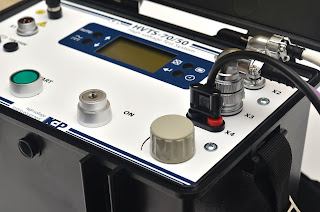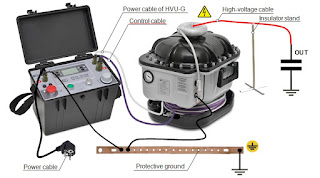 |
High voltage unit HVTS-70/50 |
Type 1 Tests typically involve one of the following:
- the insulation resistance test performed with a standard megohmmeter, also known as undervoltage test;
- the DC high potential test or DC hipot test;
- the very low frequency high potentials test (VLF hipot test);
- the AC high potential test which is performed at power frequency (50 hertz or 60 hertz).
Undervoltage tests utilizing DC voltage
Undervoltage tests are typically performed with megahometer. Since the test uses voltages under the rating of the insulation, the test is considered to be a nondestructive test and does not produce any of the harmful effects associated with a high voltage DC test. Insulation tests electrically stimulate the insulation and measure the response. Depending upon that response conclusions are drawn about the condition of the insulation.What we need to know is that if perfect insulation existed, there would be no flow of electrical current through the insulation to ground. But since no insulation has infinite resistance, there is always some leakage current flowing through the insulation. While a small amount of current leaking through a good insulation is not a problem, difficulties arise when the insulation begins to deteriorate, and the leakage current begins to increase.
The insulation resistance test measures the resistance of the insulation material to the flow of the leakage current, helping to assess the condition of the insulation. This type of test allows either to measure the resistance or the flow of the leakage current.
Overvoltage testing utilizing DC voltage
For years high voltage DC testing has been a traditionally accepted method for judging the serviceability of MV cables. DC hipots or DC high potential tests have worked well as a withstand and condition assessment test for paper insulated led-covered PILC cables. When plastic insulation cables were first introduced, DC was still the preferred measurement method.As time moved on, plastic insulated cables became more abundant and began showing aging effects and service aging. DC continued to be the dominant test, but concerns began to grow over the effectiveness of this test. Studies showed that while not causing any damage to new cables, DC hipot testing has a detrimental effect on service age cables on account of accelerating treeing effects.
 |
Hipot Test Set HVTS-70/50 |
Currently, most standards continue to include DC testing as an acceptance test on newly installed extruded dielectrics, and almost all of the recommended practices have abandoned the use of DC testing for maintenance purposes, or particularly when the cable has reached service age (is over five years of age).
To locate a cable fault with DC hipot testing, the technician needs to find the point where current leaks through the faulted insulation, and for electricity to leak, it requires a conductive path. In other words, two wires should be exposed, or there should be a wire and some other metal like the cable shield. So, in hipot testing, voltage is increased to cause leaking or arcing between exposed wires or cables, which helps to catch errors that otherwise would be missed.
Yet, there are a few reservations regarding dielectric failures that should be taken into account. It is possible for an insulation breach that results in a dielectric failure to self-heal, meaning that subsequent hipot test may actually pass. In addition, it is possible for small solder slivers which caused dielectric failures to be vaporized by the hipot test, meaning that subsequent hipot tests again may actually pass. It is also possible for these small solder slivers to leave a carbon track or be metallic sized when they are vaporized by the hipot test, meaning that subsequent hipot tests will fail. Because of these issues it is recommended that any cable that fails a hipot test be closely checked and retested at least twice.
To sum up, DC hipot testing is still widely applied for acceptance testing. Yet, when it comes to maintenance testing done in the field, VLF hipots are more commonly used, which will be discussed in more detail in the next article.
Alexei Tiatiushkin
Marketing manager
KharkovEnergoPribor Ltd.
marketing@keppowertesting.uk
Comments
Post a Comment